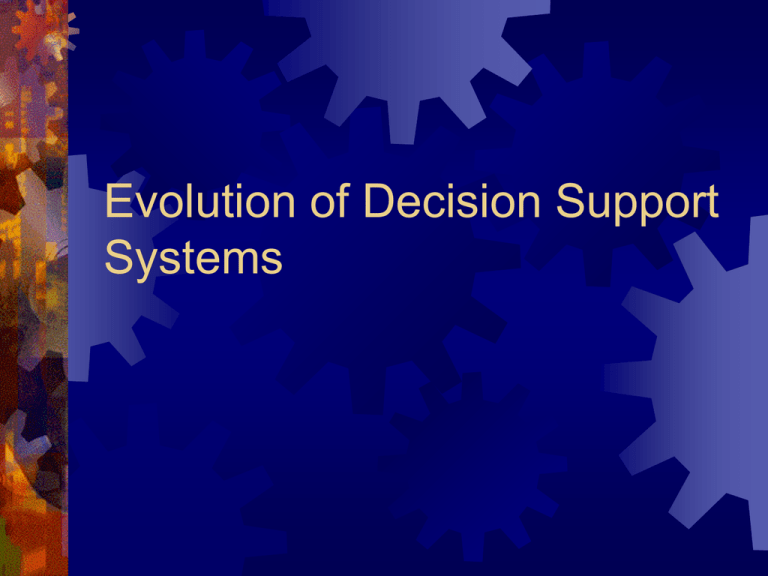Evolution of Decision Support Systems
advertisement

Evolution of Decision Support Systems Data warehouse Data warehouse ? Why Data warehouse ? What for the Data warehouse ? The Evolution 1960 (the world of computation consisted of creating individual applications that were run using master files) 1965 (complexity of maintenance and development,synchronization of data, hardware) 1970 (database-a single source of data of all processing) 1975 (online,high performance transaction processing) 1980 (Pcs, 4GL technology) Problems with the Naturally Evolving Architecture Data Credibility No time basis of data The algorithmic differential of data The levels of extraction The problem of external data No Common source of data from the beginning Productivity Inability to transform data into information The Architected Environment Level of the architecture Operational Atomic/data warehouse Most granular, time variant, integrated, subject oriented, some summary Departmental Detail, day to day, current valued, high probability of access, application oriented Parochial, some derived; some primitive, typical depts (acct, marketing, engineering, actuarial, manufacturing) Individual Temporary, ad hoc, heuristic, non repetitive, pc, workstation based Who is the user? What is the different between users of the data warehouse and users of operational environment Why need DSS analyst ? The Development Life Cycle The different between classical SDLC and Data Warehouse SDLC Classical SDLC Requirement gathering Analysis Design Programming Testing Integration Implementation Data warehouse SDLC Implement warehouse Integrate data Test for bias Program against data Design DSS system Analyze results Understand requirements Patterns of Hardware Utilization Major difference between the operational and the data warehouse environments is the pattern of hardware utilization that occurs in each environment. There are peaks and valleys in operational processing, but ultimately there is a relatively static and predictable pattern of hardware utilization. There is an essentially different pattern of hardware utilization in the data warehouse environment Setting the stage for Reengineering A very beneficial side effect of going from the production environment to the architected, data warehouse environment. Monitoring the data Warehouse Environment Two operating components are monitored on a regular basis : the data residing in the data warehouse and usage of the data. Some of the important results that are achieved by monitoring Identifying what growth is occurring, where the growth is occcurring and at what rate the growth is occuring Identifying what data is being used Calculating what response time the user is getting Determining who is actually using the data warehouse Specifying how much of the data warehouse end users are using Pinpointing when the data warehouse is being used Recognizing how much of the data ware house is being used Examining the level of usage of the data warehouse




